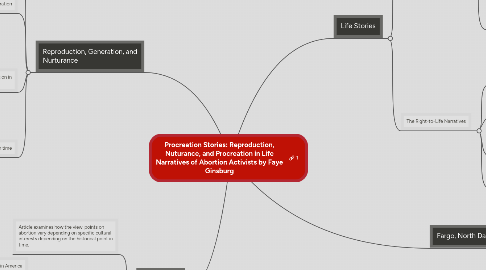
1. Reproduction, Generation, and Nurturance
1.1. Divide between pro-life and pro-choice between primarily white, middle-class families
1.1.1. Identity realignment is critical based on opinions
1.2. Distinction by Generation
1.2.1. Pro-choice activists born in 1940s
1.2.2. Pro-life activists
1.2.2.1. Born in 1920s were most active during the 1970s
1.2.2.2. Born in 1950s which are still very active
1.2.2.2.1. Large portion of activists are women who left the workforce after having children
1.3. Reasons for participation in opposing movements
1.3.1. Political – Clashing between motherhood and abortion proponents can cause social disorder.
1.3.2. Biological Factors – Through sexual and reproductive experiences, women have different interpretations and opinions about those experiences which may sway them to one side or the other.
1.4. Changes over time
1.4.1. Historically, a “fresh contact” during transitional periods, creates conditions that ensures
1.4.2. More women are in the workforce now
1.4.2.1. Women have different views on marriage, mothering and family
1.4.2.1.1. The understanding of nurturance and reproduction change
2. Conclusion
2.1. Article examines how the view-points on abortion vary depending on specific cultural interests depending on the historical point in time.
2.2. There are 2 areas of research examined in the analysis.
2.2.1. Contemporary cultural conflict in America
2.2.2. How reproduction, gender, and sexuality are shaped given cultural and social meanings.
2.3. Through 14 pro-choice and pro-life activists' stories each side offer a narrative of how their opinions have changed over time.
3. Life Stories
3.1. The Pro-Choice Narratives
3.1.1. Kay Bellevue abortions right activist since 1972
3.1.1.1. Got pregnant and married in her senior year of college
3.1.1.2. In early 20s, joined La Leche League, a group focused on promoting natural childbirth and breast feeding
3.1.1.3. Moved with family to Fargo, North Dakota in 1972, pregnant with her 5th child
3.1.1.4. Decided to have an abortion because she felt it was unfair to the other 4 children to bring another child into the family
3.1.2. Janice Sundstrom
3.1.2.1. Immediately had a child after marrying her high school sweetheart one year after graduation
3.1.2.2. She followed the church's rule of no birth control and became pregnant with a second child
3.2. The Right-to-Life Narratives
3.2.1. View abortion as women denying their reproductive consequences of having sex and rejecting female nuturance.
3.2.1.1. Believe that women whom are supportive of abortion are acting “like a man.”
3.2.2. Helen used to be pro-choice activist, has 3 children, and master's in social work.
3.2.2.1. Helen was almost aborted because mother was sick during the time she was pregnant with Helen.
3.2.3. Sally Nordensen was married shortly after college graduation, worked for several years as a social worker but left the workforce after becoming pregnant.
3.2.3.1. Viewed her decision to leave workforce as a positive because caring for family more important.
3.2.4. Shirley, a mother of 6, almost aborted one of her sons who became quite successful as an adult.
4. Fargo, North Dakota
4.1. The Fargo Women's Health Center was first stand-alone facility to publicly offer abortions.
4.1.1. Right-to-life coalition formed against the clinic almost immediately
4.1.1.1. Initially attempted to use conventional, political tactics to attack clinic, but when these attempts failed they changed strategies.
4.1.1.2. Coalition turned focus to the clientele of the clinic and wanted to be able to bring attention to the women who chose abortion.
4.1.2. Pro-choice coalition formed to counter the attacks of the right-to-life coalition and antiabortion activists.
4.1.2.1. Both pro-choice and pro-life felt as thought they were representing the “true interests of the community”
